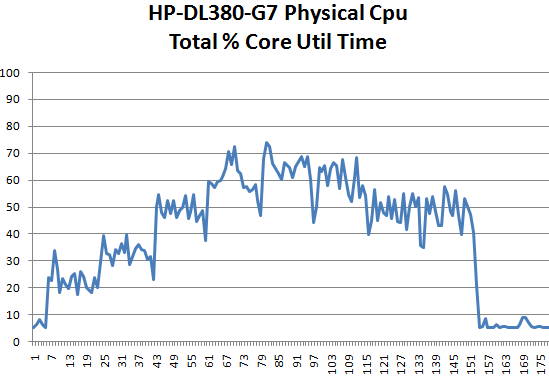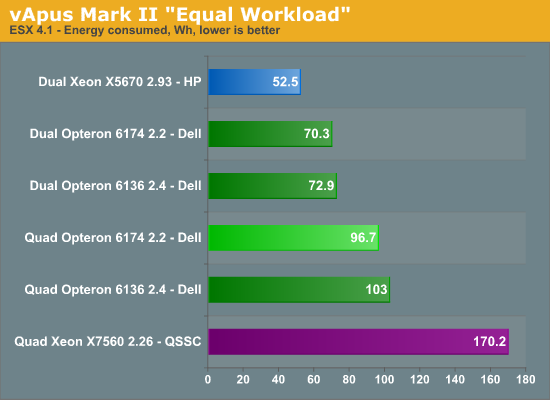Server Clash: DELL's Quad Opteron DELL R815 vs HP's DL380 G7 and SGI's Altix UV10
by Johan De Gelas on September 9, 2010 7:30 AM EST- Posted in
- IT Computing
- AMD
- Intel
- Xeon
- Opteron
Real World Power
In the real world you do not run your virtualized servers at their maximum just to measure the potential performance. Neither do they run idle. The user base will create a certain workload and expect this workload to be performed with the lowest response times. The service provider (that is you!) wants the server to finish the job with the least amount of energy consumed. So the general idea behind this new benchmark scenario is that each server runs exactly the same workload and that we then measure the amount of energy consumed. It is similar to our previous article about server power consumption, but the methodology has been enhanced.
We made a new benchmark scenario. In this scenario, we changed three things compared to the vApus Mark II scenario:
- The number of users or concurrency per VM was lowered significantly to throttle the load
- The OLTP VMs are omitted
- We ran with two tiles
vApus Mark II loads the server with up to 800 users per second on the OLAP test, up to 50 users per second on the website, and the OLTP test is performing transactions as fast as it can. The idea is to give the server so much work that it is constantly running at 95-99% CPU load, allowing us to measure throughput performance quite well. vApus Mark II is designed as a CPU/memory benchmark.
To create a real world “equal load” scenario, we throttle the number of users to a point where you typically get somewhere between 30% and 60% CPU load on modern servers. As we cannot throttle our OLTP VM (Swingbench) as far we as know, we discarded the OLTP VM in this test. If we let the OLTP test run at maximum speed, the OLTP VM would completely dominate the measurements.
We run two tiles with 14 vCPUs (eight vCPUs for OLAP, three webservers with two vCPUs per tile), so in total 28 virtual CPUs are active. There are some minor tasks in the background: a very lightly loaded Oracle databases that feeds the three websites (one per tile), the VMware console (which idles most of the time), and of course the ESX hypervisor kernel. So all in all, you have a load on about 30-31 vCPUs. That means that some of the cores of the server system will be idleing, just like in the real world. On the HP DL380 G7, this “equal workload” benchmark gives the following CPU load graph:

On the Y-axis is CPU load, and on the X-axis is the periodic CPU usage. ESXtop was set up to measure CPU load every five seconds. Each test was performed three times: two times to measure performance and energy consumption, and the third time we did the same thing but with extensive ESXtop monitoring. To avoid having the CPU load in the third run much higher than the first two, we measured every five seconds. We measure the energy consumption over 15 minutes.

Again, the dual Opteron numbers are somewhat high as we are running them in a quad socket machine. A Dell R715 is probably going to consume about 5% less. If we get the chance, we'll verify this. But even if the dual Opterons are not ideal measurements in comparison to the dual Xeon, they do give us interesting info.
Two Opterons CPUs are consuming 26.5 Wh (96.7 - 70.2). So if we extrapolate, this means roughly 55% (53 Wh out of 97Wh) of the total energy in our quad Opteron server is consumed by the four processors. Notice also that despite the small power handicap of the Opteron (a dual socket server will consume less), it was able to stay close to the Xeon X5670 based server when comparing maximum power (360W vs 330W). But once we introduce a 30-50% load, the gap between the dual Opteron setup and dual Xeon setup widens. In other words, the Opteron and Xeon are comparable at high loads, but the Xeon is able to save more power at lower loads. So there is still quite a bit of room for improvement: power gating will help the “Bulldozer” Opteron drive power consumption down at lower load.
Ok, enough interesting tidbits, who has the best performance per watt ratio?










51 Comments
View All Comments
cgaspar - Friday, September 10, 2010 - link
The word you're looking for is "authentication". Is a simple spell check so much to ask?JohanAnandtech - Friday, September 10, 2010 - link
Fixed.ESetter - Friday, September 10, 2010 - link
Great article. I suggest to include some HPC benchmarks other than STREAM. For instance, DGEMM performance would be interesting (using MKL and ACML for Intel and AMD platforms).mattshwink - Friday, September 10, 2010 - link
One thing I would like to point out is that most of the customers I work with use VMWare in an enterprise scenario. Failover/HA is usually a large issue. As such we usually create (or at least recommend) VMWare clusters with 2 or 3 nodes. As such each node is limited to roughly 40% usage (memory/CPU) so that if a failure occurs there is minimal/0 service disruption. So we usually don't run highly loaded ESX hosts. So the 40% load numbers are the most interesting. Good article and lots to think about when deploying these systems....lorribot - Friday, September 10, 2010 - link
It would be nice to see some comparisons of blade systems in a similar vein to this article.Also you say that one system is better at say DBs whilst the the other is better at VMware, what about if you are running say a SQL database on a VMware platform? Which one would be best for that? How much does the application you are running in the VM affect the comparative performance figures you produce?
spinning rust - Saturday, September 11, 2010 - link
is it really a question, anyone who has used both DRAC and ILO knows who wins. everyone at my current company has a tear come to their eyes when we remember ILO. over 4 years of supporting Proliants vs 1 year of Dell, i've had more hw problems with Dell. i've never before seen firmware brick a server, but they did it with a 2850, the answer, new motherboard. yay!pablo906 - Saturday, September 11, 2010 - link
This article should be renamed servers clash, finding alternatives to the Intel architecture. Yes it's slightly overpriced but it's extremely well put together. Only in the last few months has the 12c Opteron become an option. It's surprising you can build Dell 815's with four 71xx series and 10GB Nics for under a down payment on a house. This was not the case recently. It's a good article but it's clearly aimed to show that you can have great AMD alternatives for a bit more. The most interesting part of the article was how well AMD competed against a much more expensive 7500 series Xeon server. I enjoyed the article it was informative but the showdown style format was simply wrong for the content. Servers aren't commodity computers like desktops. They are aimed at a different type of user and I don't think that showdowns of vastly dissimilar hardware, from different price points and performance points, serve to inform IT Pros of anything they didn't already know. Spend more money for more power and spend it wisely......echtogammut - Saturday, September 11, 2010 - link
First off, I am glad that Anandtech is reviewing server systems, however I came away with more questions than answers after reading this article.First off, please test comparable systems. Your system specs were all over the board and there were way to many variables that can effect performance for any relevant data to be extracted from your tests.
Second, HP, SGI and Dell will configure your system to spec... i.e. use 4GB dimms, drives, etcetera if you call them. However something that should be noted is that HP memory must be replaced with HP memory, something that is an important in making a purchase. HP, puts a "thermal sensor" on their dimms, that forces you to buy their overpriced memory (also the reason they will use 1GB dimms, unless you spec otherwise).
Third, if this is going to be a comparison, between three manufactures offerings, compare those offerings. I came away feeling I should buy an IBM system (which wasn't even "reviewed")
Lastly read the critiques others have written here, most a very valid.
JohanAnandtech - Monday, September 13, 2010 - link
"First off, please test comparable systems."I can not agree with this. I have noticed too many times that sysadmins make the decision to go for a certain system too early, relying too much on past experiences. The choice for "quad socket rack" or "dual socket blade" should not be made because you are used to deal with these servers or because your partner pushes you in that direction.
Just imagine that the quad Xeon 7500 would have done very well in the power department. Too many people would never consider them because they are not used to buy higher end systems. So they would populate a rack full of blades and lose the RAS, scalability and performance advantages.
I am not saying that this gutfeeling is wrong most of the time, but I am advocating to keep an open mind. So the comparison of very different servers that can all do the job is definitely relevant.
pablo906 - Saturday, September 11, 2010 - link
These VMWare benchmarks are worthless. I've been digesting this for a long long time and just had a light bulb moment when re-reading the review. You run highly loaded Hypervisors. NOONE does this in the Enterprise space. To make sure I'm not crazy I just called several other IT folks who work in large (read 500+ users minimum most in the thousands) and they all run at <50% load on each server to allow for failure. I personally run my servers at 60% load and prefer running more servers to distribute I/O than running less servers to consolidate heavily. With 3-5 servers I can really fine tune the storage subsystem to remove I/O bottlenecks from both the interface and disk subsystem. I understand that testing server hardware is difficult especially from a Virtualization standpoint, and I can't readily offer up better solutions to what you're trying to accomplish all I can say is that there need to be more hypervisors tested and some thought about workloads would go a long way. Testing a standard business on Windows setup would be informative. This would be an SQL Server, an Exchange Server, a Share Point server, two DC's, and 100 users. I think every server I've ever seen tested here is complete overkill for that workload but that's an extremely common workload. A remote environment such as TS or Citrix is another very common use of virtualization. The OS craps out long before hardware does when running many users concurrently in a remote environment. Spinning up many relatively weak VM's is perfect for this kind of workload. High performance Oracle environments are exactly what's being virtualized in the Server world yet it's one of your premier benchmarks. I've never seen a production high load Oracle environment that wasn't running on some kind of physical cluster with fancy storage. Just my 2 cents.